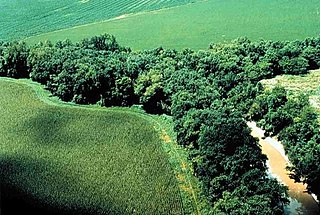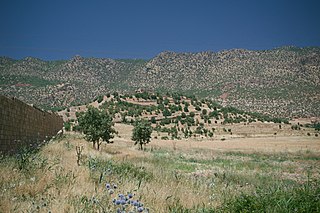
Populus is a genus of 25–30 species of deciduous flowering plants in the family Salicaceae, native to most of the Northern Hemisphere. English names variously applied to different species include poplar, aspen, and cottonwood.

A riparian zone or riparian area is the interface between land and a river or stream. Riparian is also the proper nomenclature for one of the terrestrial biomes of the Earth. Plant habitats and communities along the river margins and banks are called riparian vegetation, characterized by hydrophilic plants. Riparian zones are important in ecology, environmental resource management, and civil engineering because of their role in soil conservation, their habitat biodiversity, and the influence they have on fauna and aquatic ecosystems, including grasslands, woodlands, wetlands, or even non-vegetative areas. In some regions, the terms riparian woodland, riparian forest, riparian buffer zone,riparian corridor, and riparian strip are used to characterize a riparian zone. The word riparian is derived from Latin ripa, meaning "river bank".

The Tarim Basin deciduous forests and steppe is a temperate broadleaf and mixed forests ecoregion in the Xinjiang Uyghur Autonomous Region of western China. The ecoregion includes deciduous riparian forests and steppes sustained by the region's rivers in an otherwise arid region.

The forestry sector of Pakistan is a main source of lumber, paper, fuelwood, latex, medicine as well as food and provide ecotourism and wildlife conservation purposes. 4.91% of Pakistan's land is covered in forest.The Shangla district is the only district of Pakistan that composed of more than 80% of forest land
Phyllonorycter pruinosella is a moth of the family Gracillariidae. It is known from Central Asia, Kazakhstan, Tajikistan, Turkmenistan and Uzbekistan.

Streptomyces hygroscopicus is a bacterial species in the genus Streptomyces. It was first described by Hans Laurits Jensen in 1931.

Populus euphratica, commonly known as the Euphrates poplar, desert poplar, diversiform-leaved poplar, or poplar diversifolia, is a species of poplar tree in the willow family.
Sphingobacterium hotanense is a Gram-negative, strictly aerobic and non-motile bacterium from the genus of Sphingobacterium which has been isolated from the Populus euphratica forest from the Hotan River valley in China.
Sphingobacterium shayense is a bacterium from the genus of Sphingobacterium which has been isolated from forest soil from a Populus euphratica forest in Xinjiang in China.
Niastella is a bacterial genus from the family of Chitinophagaceae.
Niastella populi is a Gram-negative, strictly aerobic and non-motile bacterium from the genus of Niastella which has been isolated from soli from a Populus euphratica forest in Xinjiang in China.
Pontibacter populi is a Gram-negative, rod-shaped and non-motile bacterium from the genus of Pontibacter which has been isolated from soil from a Populus euphratica forest in Xinjiang in China.
Pontibacter yuliensis is a Gram-negative and rod-shaped bacterium from the genus of Pontibacter which has been isolated from soil from a Populus euphratica forest in the Taklamakan desert in Xinjiang in China.
Streptomyces indoligenes is a Gram-positive bacterium species from the genus of Streptomyces which has been isolated from rhizosphere soil from the tree Populus euphratica in Xinjiang in China.
Flavitalea populi is a Gram-negative, rod-shaped, aerobic and non-motile bacterium from the genus of Flavitalea which has been isolated from soil from the plant Populus euphratica from a forest in Xinjiang in China.
Parasegetibacter luojiensis is a Gram-negative, strictly aerobic, non-spore-forming, heterotrophic and motile bacterium from the genus of Parasegetibacter which has been isolated from forest soil from the tree Populus euphratica from Xinjiang in China.

The Middle East steppe ecoregion stretches in an arc from southern Jordan across Syria and Iraq to the western border of Iran. The upper plains of the Tigris and Euphrates Rivers dominate most of the ecoregion. The terrain is mostly open shrub steppe. The climate is arid. Evidence is that this region was once more of a forest-steppe, but centuries of overgrazing and gathering firewood have reduced tree and grass cover to small areas and along the riverine corridors. Despite the degraded condition of the steppe environment, the ecoregion is important for water birds as the rivers and reservoirs provide habitat in the arid region.

The Mesopotamian shrub desert is a deserts and xeric shrublands ecoregion in Western Asia. It extends across portions of Israel, Jordan, Syria, Iraq, and Iran.
Streptomyces populi is an endophytic bacterium species from the genus of Streptomyces which has been isolated from the stem of the tree Populus adenopoda from the Mount Qingcheng in China.
Streptomyces paludis is a Gram-positive bacterium species from the genus of Streptomyces which has been isolated from alpine wetland soil.







